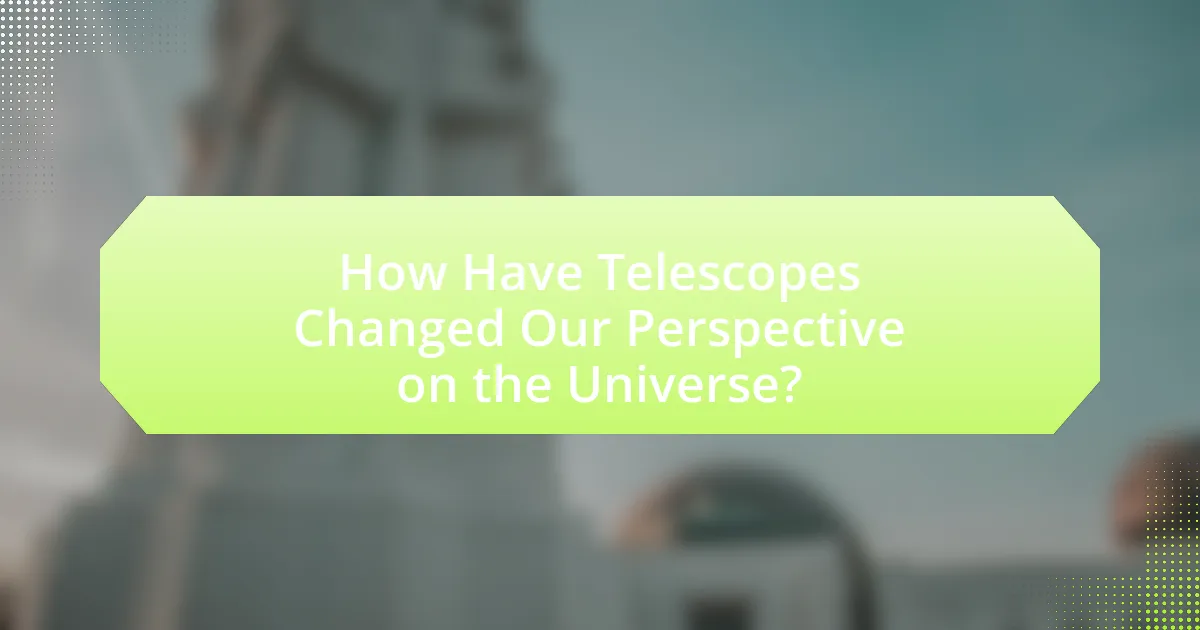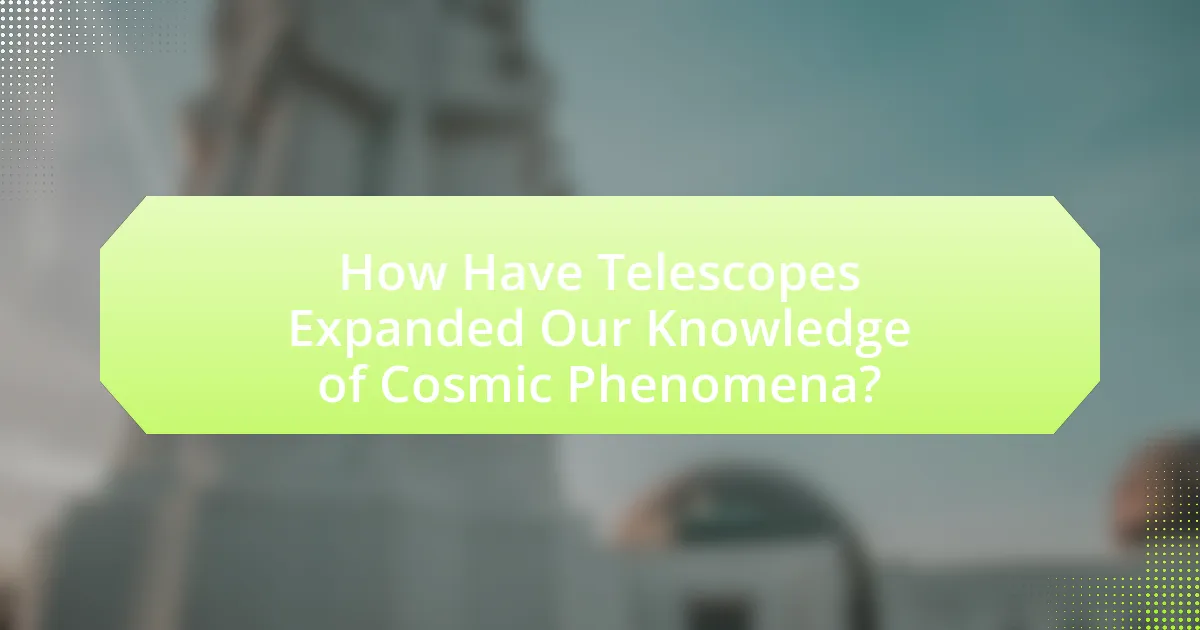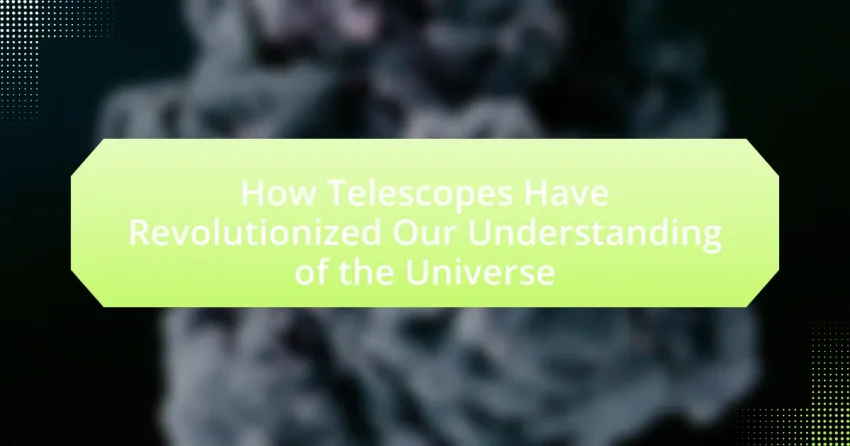Telescopes have revolutionized our understanding of the universe by enabling detailed observations of celestial objects and phenomena that are not visible to the naked eye. The article outlines key milestones in telescope development, from the refracting telescope of the 17th century to modern advancements like the Hubble Space Telescope and upcoming technologies. It discusses how telescopes have contributed to significant discoveries, including the existence of dark energy, the expansion of the universe, and the identification of exoplanets. Additionally, the article highlights the importance of different types of telescopes, their roles in astronomical research, and the challenges faced by astronomers in utilizing these instruments effectively.

How Have Telescopes Changed Our Perspective on the Universe?
Telescopes have fundamentally transformed our perspective on the universe by enabling humanity to observe celestial objects and phenomena that are otherwise invisible to the naked eye. The invention of the refracting telescope in the early 17th century allowed astronomers like Galileo to discover moons orbiting Jupiter and the phases of Venus, providing evidence for the heliocentric model of the solar system.
Subsequent advancements, such as the development of reflecting telescopes and space-based observatories like the Hubble Space Telescope, have expanded our view to distant galaxies, nebulae, and cosmic events like supernovae. For instance, Hubble has captured images of galaxies billions of light-years away, revealing the universe’s vastness and the existence of dark energy, which constitutes about 68% of the universe.
These observations have led to significant scientific breakthroughs, including the understanding of the universe’s expansion and the formation of cosmic structures. Thus, telescopes have not only enhanced our knowledge of the cosmos but have also reshaped our understanding of our place within it.
What are the key milestones in telescope development?
The key milestones in telescope development include the invention of the refracting telescope by Hans Lippershey in 1608, which allowed for the first magnified observations of celestial bodies. Galileo Galilei’s improvements to this design in 1610 enabled him to discover Jupiter’s moons, significantly advancing our understanding of the solar system. The introduction of the reflecting telescope by Isaac Newton in 1668 further enhanced observational capabilities by reducing chromatic aberration. In the 20th century, the launch of the Hubble Space Telescope in 1990 marked a pivotal moment, providing unprecedented clarity and depth in astronomical observations, leading to discoveries such as the acceleration of the universe’s expansion. Each of these milestones has played a crucial role in shaping modern astronomy and our comprehension of the universe.
How did early telescopes contribute to our understanding of celestial bodies?
Early telescopes significantly advanced our understanding of celestial bodies by allowing astronomers to observe details that were previously invisible to the naked eye. For instance, Galileo’s use of the telescope in the early 17th century revealed the moons of Jupiter, demonstrating that not all celestial bodies orbit the Earth, which supported the heliocentric model proposed by Copernicus. Additionally, telescopes enabled the observation of the phases of Venus and the detailed surface of the Moon, providing evidence for the dynamic nature of celestial objects. These observations fundamentally changed the perception of the universe, shifting it from an Earth-centered view to one that recognized the complexity and vastness of the cosmos.
What advancements have modern telescopes introduced?
Modern telescopes have introduced advancements such as adaptive optics, which significantly improve image clarity by compensating for atmospheric distortion. This technology allows telescopes to achieve resolutions comparable to those in space, enabling astronomers to observe distant celestial objects with unprecedented detail. For instance, the Keck Observatory in Hawaii utilizes adaptive optics to enhance its observations, allowing for the study of exoplanets and the detailed mapping of galaxies. Additionally, modern telescopes are equipped with advanced sensors and detectors, such as CCDs (Charge-Coupled Devices), which enhance light sensitivity and enable the capture of faint astronomical phenomena. These advancements collectively enhance our ability to explore and understand the universe.
Why are telescopes essential for astronomical research?
Telescopes are essential for astronomical research because they enable the observation of distant celestial objects, providing critical data about the universe. By collecting and magnifying light from stars, galaxies, and other astronomical phenomena, telescopes allow scientists to analyze their properties, such as composition, distance, and motion. For instance, the Hubble Space Telescope has captured images that have led to significant discoveries, including the rate of expansion of the universe, which is estimated at approximately 73 kilometers per second per megaparsec. This capability to observe and gather data from vast distances is fundamental for advancing our understanding of cosmic events and the overall structure of the universe.
How do telescopes enhance our ability to observe distant galaxies?
Telescopes enhance our ability to observe distant galaxies by collecting and magnifying light from these far-off celestial objects, allowing for detailed analysis. The design of telescopes, particularly their large apertures, enables them to gather more light than the human eye, which is crucial for observing faint galaxies that are billions of light-years away. For instance, the Hubble Space Telescope, with its 2.4-meter mirror, has captured images of galaxies that are over 13 billion years old, providing insights into the early universe. This capability to observe light across various wavelengths, including infrared and ultraviolet, further allows astronomers to study the composition, structure, and dynamics of distant galaxies, leading to a deeper understanding of cosmic evolution.
What role do telescopes play in discovering exoplanets?
Telescopes play a crucial role in discovering exoplanets by enabling astronomers to detect and analyze distant worlds beyond our solar system. They utilize various methods, such as the transit method, where telescopes monitor the brightness of stars for periodic dimming caused by a planet passing in front of them. For instance, NASA’s Kepler Space Telescope, launched in 2009, identified over 2,300 confirmed exoplanets using this technique, demonstrating the effectiveness of telescopes in expanding our knowledge of planetary systems. Additionally, ground-based telescopes equipped with advanced spectrographs can analyze the atmospheres of exoplanets, providing insights into their composition and potential habitability.
What are the different types of telescopes and their functions?
The different types of telescopes include optical telescopes, radio telescopes, infrared telescopes, ultraviolet telescopes, X-ray telescopes, and gamma-ray telescopes, each serving distinct functions in astronomical observation. Optical telescopes, which utilize lenses or mirrors to gather visible light, allow astronomers to observe celestial objects in detail, while radio telescopes detect radio waves emitted by astronomical sources, enabling the study of phenomena like pulsars and cosmic microwave background radiation. Infrared telescopes capture infrared radiation, revealing cooler objects such as dust clouds and distant galaxies, whereas ultraviolet telescopes focus on ultraviolet light to study hot stars and the interstellar medium. X-ray telescopes are designed to observe high-energy phenomena like black holes and supernova remnants, and gamma-ray telescopes detect gamma rays to explore the most energetic events in the universe, such as gamma-ray bursts. Each type of telescope plays a crucial role in expanding our understanding of the universe by providing unique insights into various astronomical phenomena.
How do optical telescopes differ from radio telescopes?
Optical telescopes differ from radio telescopes primarily in the type of electromagnetic radiation they detect. Optical telescopes capture visible light, allowing astronomers to observe celestial objects in detail, while radio telescopes detect radio waves, enabling the study of phenomena that are not visible in the optical spectrum, such as cosmic microwave background radiation and pulsars. The design of optical telescopes typically includes lenses or mirrors to focus light, whereas radio telescopes use large parabolic dishes to collect and focus radio waves. This fundamental difference in detection methods allows each type of telescope to provide unique insights into the universe, contributing to a more comprehensive understanding of astronomical phenomena.
What unique insights do space telescopes provide compared to ground-based telescopes?
Space telescopes provide unique insights by observing celestial phenomena without the interference of Earth’s atmosphere, which distorts light and limits the wavelengths that can be detected. This capability allows space telescopes, such as the Hubble Space Telescope, to capture clearer images and data across a broader spectrum, including ultraviolet and infrared wavelengths. For example, Hubble’s observations have led to the discovery of exoplanets and provided detailed insights into the formation of galaxies, which ground-based telescopes struggle to achieve due to atmospheric turbulence. Additionally, space telescopes can operate continuously without the interruptions caused by weather or daylight, enabling more consistent and comprehensive data collection.

How Have Telescopes Expanded Our Knowledge of Cosmic Phenomena?
Telescopes have significantly expanded our knowledge of cosmic phenomena by enabling detailed observation of celestial objects and events. For instance, the Hubble Space Telescope has provided high-resolution images of distant galaxies, revealing their formation and evolution over billions of years. This has led to the discovery of phenomena such as dark energy, which constitutes approximately 68% of the universe, and the identification of exoplanets through transit methods, enhancing our understanding of planetary systems beyond our own. Additionally, radio telescopes have detected cosmic microwave background radiation, offering insights into the early universe and supporting the Big Bang theory. These advancements illustrate how telescopes have transformed our comprehension of the cosmos through empirical evidence and groundbreaking discoveries.
What discoveries have telescopes made about black holes?
Telescopes have made significant discoveries about black holes, including the first direct image of a black hole’s event horizon captured by the Event Horizon Telescope in 2019. This groundbreaking image of the supermassive black hole in the galaxy M87 provided visual evidence of black holes’ existence and confirmed predictions made by general relativity. Additionally, telescopes have detected gravitational waves from black hole mergers, first observed by LIGO in 2015, which further validated the existence of black holes and their properties. These discoveries have fundamentally enhanced our understanding of black holes and their role in the universe.
How do telescopes help us understand the formation of black holes?
Telescopes help us understand the formation of black holes by allowing astronomers to observe high-energy phenomena associated with their creation, such as supernovae and the accretion of matter. For instance, the Hubble Space Telescope has captured images of the remnants of massive stars that have exploded, providing insights into the conditions that lead to black hole formation. Additionally, telescopes equipped with advanced sensors can detect gravitational waves, which are ripples in spacetime caused by the collision of black holes, further enhancing our understanding of their formation processes. These observations contribute to the theoretical models of black hole formation, confirming predictions made by general relativity and other astrophysical theories.
What evidence do telescopes provide regarding supermassive black holes at galaxy centers?
Telescopes provide compelling evidence of supermassive black holes at galaxy centers through the observation of high-velocity stars and gas orbiting around an unseen mass. For instance, the Keck Observatory in Hawaii has tracked stars near the center of the Milky Way, revealing that they orbit a massive object with approximately four million times the mass of the Sun, identified as Sagittarius A*. Additionally, the Event Horizon Telescope has captured images of the shadow of a black hole in the galaxy M87, providing direct visual evidence of its existence. These observations confirm the presence of supermassive black holes as central components of galaxies, supported by the correlation between black hole mass and the properties of their host galaxies.
How have telescopes contributed to our understanding of the Big Bang?
Telescopes have significantly advanced our understanding of the Big Bang by enabling the observation of cosmic microwave background radiation, which is the afterglow of the Big Bang. This radiation, first detected by the COBE satellite in 1992, provides critical evidence for the Big Bang theory, confirming that the universe was once in a hot, dense state. Additionally, telescopes like the Hubble Space Telescope have allowed astronomers to observe distant galaxies and their redshifts, which support the expansion of the universe, a key prediction of the Big Bang model. These observations collectively reinforce the timeline and conditions of the early universe, solidifying the Big Bang as the leading explanation for the origin of the cosmos.
What observations support the Big Bang theory?
The observations that support the Big Bang theory include the cosmic microwave background radiation, the abundance of light elements, and the redshift of galaxies. Cosmic microwave background radiation, discovered by Arno Penzias and Robert Wilson in 1965, is the afterglow of the Big Bang, uniformly detected across the universe, indicating a hot, dense origin. The abundance of light elements, such as hydrogen and helium, aligns with predictions from Big Bang nucleosynthesis, which suggests these elements formed in the first few minutes after the Big Bang. Additionally, the redshift of galaxies, observed by Edwin Hubble, shows that galaxies are moving away from us, implying that the universe is expanding, a key prediction of the Big Bang theory.
How do telescopes measure cosmic background radiation?
Telescopes measure cosmic background radiation by detecting the faint microwave signals emitted from the early universe, specifically from the cosmic microwave background (CMB) radiation. Instruments like the Wilkinson Microwave Anisotropy Probe (WMAP) and the Planck satellite utilize sensitive detectors to capture these signals, which are uniform across the sky but exhibit slight temperature fluctuations. These fluctuations provide critical information about the universe’s age, composition, and evolution, confirming the Big Bang theory and allowing scientists to map the structure of the universe. The CMB was first discovered in 1965 by Arno Penzias and Robert Wilson, providing empirical evidence for the hot Big Bang model.
What is the significance of telescopes in studying dark matter and dark energy?
Telescopes are significant in studying dark matter and dark energy because they enable astronomers to observe cosmic phenomena that reveal the effects of these mysterious components of the universe. For instance, telescopes like the Hubble Space Telescope have provided critical data on the distribution of galaxies and the cosmic microwave background radiation, which are essential for understanding the influence of dark matter on galaxy formation and the expansion of the universe. Additionally, observations of supernovae using ground-based and space telescopes have led to the discovery of dark energy, as they showed that the universe’s expansion is accelerating. These observations are supported by the fact that the redshift of distant galaxies correlates with their distance, indicating the presence of dark energy driving this acceleration.
How do telescopes help in mapping dark matter in the universe?
Telescopes help in mapping dark matter in the universe by observing the gravitational effects of dark matter on visible matter, radiation, and the large-scale structure of the universe. For instance, telescopes can detect gravitational lensing, where light from distant galaxies is bent around massive objects, indicating the presence of dark matter. Studies, such as those conducted by the Hubble Space Telescope, have provided evidence of dark matter’s distribution by analyzing the light distortions caused by its gravitational influence. This method allows astronomers to infer the location and amount of dark matter in galaxy clusters, contributing to a more comprehensive understanding of the universe’s composition.
What role do telescopes play in understanding the expansion of the universe?
Telescopes play a crucial role in understanding the expansion of the universe by allowing astronomers to observe distant galaxies and measure their redshifts. The redshift phenomenon indicates how fast these galaxies are moving away from us, which is a direct consequence of the universe’s expansion. For instance, Edwin Hubble’s observations in the 1920s revealed a correlation between the distance of galaxies and their redshift, leading to the formulation of Hubble’s Law. This law quantitatively describes the rate of expansion, providing evidence that the universe is not static but continuously expanding. Thus, telescopes are essential tools for gathering the data necessary to comprehend the dynamics of cosmic expansion.

What Future Developments Can We Expect in Telescope Technology?
Future developments in telescope technology will likely include advancements in adaptive optics, increased sensitivity through larger apertures, and the integration of artificial intelligence for data analysis. Adaptive optics will enhance image clarity by compensating for atmospheric distortion, as demonstrated by the Keck Observatory’s systems. Larger telescopes, such as the Extremely Large Telescope (ELT) with a 39-meter aperture, will capture fainter objects, expanding our observational capabilities. Additionally, AI algorithms are being developed to process vast amounts of astronomical data more efficiently, as seen in projects like the Vera C. Rubin Observatory, which aims to revolutionize time-domain astronomy. These innovations will significantly enhance our ability to explore and understand the universe.
How will upcoming telescopes enhance our exploration of the universe?
Upcoming telescopes will enhance our exploration of the universe by providing unprecedented resolution and sensitivity to observe distant celestial objects and phenomena. For instance, the James Webb Space Telescope, set to launch in December 2021, is designed to capture light from the earliest galaxies, allowing astronomers to study the formation of stars and planets in detail. Additionally, the Extremely Large Telescope, expected to be operational in the late 2020s, will utilize advanced adaptive optics to correct atmospheric distortions, enabling clearer images of exoplanets and their atmospheres. These advancements will significantly expand our understanding of cosmic evolution, the nature of dark matter, and the potential for life beyond Earth.
What features will the next generation of space telescopes include?
The next generation of space telescopes will include advanced features such as larger apertures, improved sensitivity, and enhanced imaging capabilities. These telescopes, like the James Webb Space Telescope, are designed to observe a wider range of wavelengths, from infrared to visible light, allowing for deeper exploration of the universe. Additionally, they will incorporate technologies like adaptive optics and coronagraphy to minimize the effects of atmospheric distortion and to directly image exoplanets. These advancements are supported by ongoing research and development in astrophysics and engineering, ensuring that future telescopes can provide unprecedented insights into cosmic phenomena.
How might advancements in technology improve telescope sensitivity and resolution?
Advancements in technology can significantly improve telescope sensitivity and resolution through enhanced sensor capabilities and adaptive optics systems. For instance, the development of larger and more sensitive detectors, such as charge-coupled devices (CCDs), allows telescopes to capture fainter light from distant celestial objects, increasing sensitivity. Additionally, adaptive optics technology compensates for atmospheric distortion in real-time, resulting in sharper images and improved resolution. The Keck Observatory, utilizing adaptive optics, has demonstrated a tenfold increase in resolution compared to traditional imaging methods, showcasing the effectiveness of these technological advancements.
What challenges do astronomers face with current telescope technology?
Astronomers face several challenges with current telescope technology, including limitations in resolution, sensitivity, and atmospheric interference. The resolution of telescopes is often constrained by diffraction limits, which restricts the ability to distinguish between closely spaced celestial objects. Sensitivity issues arise from the need to detect faint light from distant astronomical sources, requiring advanced detectors and longer exposure times. Additionally, atmospheric interference, such as turbulence and light pollution, can distort images and reduce the clarity of observations. These challenges necessitate ongoing advancements in telescope design and technology to enhance observational capabilities and improve our understanding of the universe.
How do atmospheric conditions affect ground-based telescopes?
Atmospheric conditions significantly affect ground-based telescopes by introducing turbulence, absorption, and scattering of light. Turbulence in the atmosphere causes star images to twinkle, which degrades image quality and limits resolution. For instance, atmospheric turbulence can distort light from celestial objects, leading to a phenomenon known as “seeing,” which is quantified by the Fried parameter; better seeing conditions correlate with a larger Fried parameter, indicating less distortion. Additionally, atmospheric absorption, particularly by water vapor and carbon dioxide, can diminish the intensity of certain wavelengths of light, impacting the data collected by telescopes. Scattering of light due to atmospheric particles can also reduce contrast and clarity in astronomical images. These factors collectively hinder the ability of ground-based telescopes to capture clear and detailed observations of distant celestial phenomena.
What are the limitations of current telescope designs in observing distant objects?
Current telescope designs face limitations in observing distant objects primarily due to atmospheric interference, resolution constraints, and light pollution. Atmospheric interference, caused by the Earth’s atmosphere, distorts incoming light, which can blur images and reduce clarity. Resolution constraints arise from the diffraction limit, which restricts the ability to distinguish between closely spaced objects; for instance, ground-based telescopes are limited by the size of their apertures. Light pollution from urban areas further hampers observations by overwhelming faint celestial objects, making them difficult to detect. These factors collectively hinder the effectiveness of telescopes in capturing detailed images of distant astronomical phenomena.
What practical tips can enhance the use of telescopes for amateur astronomers?
To enhance the use of telescopes for amateur astronomers, it is essential to ensure proper alignment and calibration of the telescope. Accurate alignment allows for precise tracking of celestial objects, which is crucial for effective observation. Additionally, using a star chart or astronomy app can help identify and locate objects in the night sky, improving the overall experience. Regular maintenance, such as cleaning the lenses and checking for mechanical issues, also contributes to optimal performance. Research indicates that amateur astronomers who engage in these practices report a significantly improved observational experience, leading to a deeper understanding of astronomical phenomena.
How can beginners choose the right telescope for their needs?
Beginners can choose the right telescope by considering their primary interests, budget, and the type of celestial objects they wish to observe. For instance, if a beginner is interested in planetary observation, a telescope with a higher magnification, such as a refractor or a compound telescope, would be suitable. Conversely, for deep-sky observation, a larger aperture reflecting telescope is recommended to gather more light.
Budget is also crucial; entry-level telescopes typically range from $100 to $500, and it’s essential to balance cost with quality to avoid frustration. Additionally, portability and ease of setup should be considered, especially for beginners who may want to travel to darker skies for better viewing conditions.
Research indicates that beginners often benefit from telescopes with user-friendly features, such as computerized mounts, which can help locate celestial objects easily. According to a study by the American Astronomical Society, starting with a simpler telescope can enhance the learning experience and foster a deeper interest in astronomy.
What techniques can improve viewing experiences through telescopes?
Techniques that can improve viewing experiences through telescopes include using high-quality optics, employing proper alignment and calibration, and utilizing filters. High-quality optics enhance image clarity and reduce distortion, allowing for better observation of celestial objects. Proper alignment and calibration ensure that the telescope is accurately pointed at the desired target, which is crucial for effective viewing. Additionally, using filters can enhance contrast and reduce light pollution, making faint objects more visible. These techniques are supported by the fact that amateur astronomers often report significantly improved viewing experiences when implementing these methods, as evidenced by numerous observational studies and user testimonials in astronomy forums.
